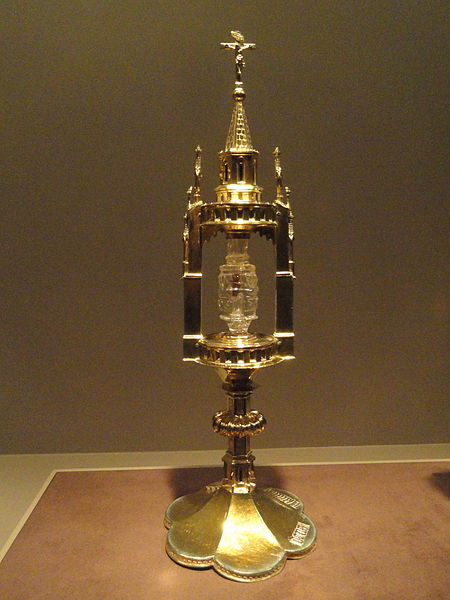I recently tackled the public discussion in Germany about whether to rename the Stiftung Preussischer Kulturbesitz, the foundation that oversees the State Museums of Berlin and some of the most remarkable collections in the world. Readers of the Art Law Report will know this name well, the SPK is the defendant in the lawsuit brought by my clients for the restitution of the Welfenschatz, or Guelphe Treasure, that the Supreme Court heard in 2020. While I've never been shy about criticizing the SPK about its approach in our our case (which is on appeal, briefs here and here), this piece addresses a different question. Namely, what place does the name "Prussia" have in the 21st century? For anyone like me who still thinks about the historical sliding doors of the Grossdeutschelösung and Kleindeutschelösungdebate of the 19th century about how to unite the German-speaking states and duchies, this piece is for you.
Read More
Topics:
Holy Roman Empire,
Prussia,
"Elephant Mural",
Martin Luther,
Stiftung Preussischer Kulturbesitz,
Sueddeutsche Zeitung,
Hermann Goering,
Der Spiegel,
Prussian Cultural Heritage Foundation,
Andy Warhol,
Welfenschatz,
Humboldt Forum,
C. Montgomery Burns,
Claudia Roth,
Siam,
Sigismund of Luxembourg,
Friedrich VI,
Hohenzollern,
Brandenburg,
Kaliningrad,
Augustus II the Strong,
Nefertiti,
Pergamon Altar,
Annalena Bärbock,
Monika Grütters,
Götz Aly,
Joseph Beuys,
Königsberg,
Nazism,
Konrad Adenauer,
Hermann Parzinger,
Luf Boat,
Bild
While the incomparable Goodnight Moon by Margaret Wise Brown and illustrated by Clement Hurd does not take place in Dresden, that is where today brought news of a robbery at the Staatliche Kunstsammlungen Dresden, the State Art Collections that house the treasures of the Free State of Saxony. Specifically, two thieves broke into the Grünes Gewölbe—the Green Vault—which holds the rarest objects of all. Headlines understandably honed in on monetary values in the hundreds of millions or even billions, but these objects are, in fact, priceless. It is a horrifying crime against a rich cultural heritage in an historic city.
Read More
Topics:
Holy Roman Empire,
Dresden,
DDR,
Gemäldegalerie Dresden,
Isabella Stewart Gardner Museum Theft,
Staatliche Kunstsammlungen Dresden,
East Germany,
Tashkent,
Paris Court of Appeal,
Goodnight Moon,
Anne Hawley,
House of Wettin,
Augustus the Strong,
Zwinger,
Frauenkirche,
Rezidenzschloss,
Fürstenzug,
Gottfried Semper,
Grünes Gewölbe,
Margaret Wise Brown,
Clement Hurd,
Residenzschloss,
Green Vault,
Thomas Crown affair,
Bond villain,
Marion Ackerman,
Michael Kretschmer,
Free State of Saxony,
Freistaat Sachsen,
Electorate of Saxony,
Thirty Years War,
Schatzkammer,
Wittelsbach,
GDR
One of the issues exposed and exacerbated by the ongoing Gurlitt collection stalemate is the question of Germany’s restitution procedures with respect to art. As the Bavarian legislative proposal to abolish the statute of limitations for claims against bad-faith acquirers is considered by the Bundestag, the “German Advisory Commission for the Return of Cultural Property Seized as a Result of Nazi Persecution, Especially Jewish Property” has issued a decision over what has become known as the “Guelph Treasure” (Welfenschatz) in the collection of the Stiftung Preussischer Kulturbesitz (SPK), the Prussian Cultural Heritage Foundation. The March 20, 2014 opinion (available, so far as I know, only in German at this point at www.lostart.de) underscores the issues around claims of sales under duress, and the appropriate present-day procedural remedy. Readers should also brush up on their medieval German history to keep up.
Read More
Topics:
Holy Roman Emperor Otto IV,
German Supreme Commercial Court,
Holy Roman Empire,
Bundeshandelsgericht,
German Supreme Constitutional Court,
Z.M. Hackenbroch,
Karl Blechen,
Duchy of Brunswick and Lüneburg,
Niedersachsen,
Karl Ernst Baumann,
Act of State,
Kingdom of Hanover. Königreich Hannover,
Dr Alexander Lewin,
Prussia,
Lower Saxony,
Anselm Feuerbach,
Gurlitt Collection,
Foreign Sovereign Immunities Act,
Preussen,
Hans Sachs,
German Advisory Commission for the Return of Cultu,
Hessen,
Fogg Art Museum,
Congress of Vienna,
Julius and Clara Freund,
Kurhannover,
Dresdner Bank,
Hermann Goring,
Austrian Supreme Court,
Johann J. August von der Embde,
House of Welf,
Stiftung Preussischer Kulturbesitz,
Wilhelm Leibl,
Portrait of Amalie Zuckerkandl,
Braunschweig-Lüneburg,
Harvard,
Portrait der Familie von Dithfurth,
Gurlitt,
Restitution,
George I,
J.S. Goldschmidt,
World War II,
Peasant Girl without a Hat and with a White Headcl,
Queen Victoria,
Prussian Cultural Heritage Foundation,
Art Institute of Chicago,
Kurfürsten,
Jutta Limbach,
www.lostart.de,
Soviet Union,
Gustav Klimt,
Bundesverfassungsgericht,
Welfenschatz,
Limbach Commission,
I. Rosenbaum,
Electors


.jpg)


